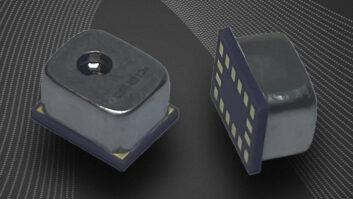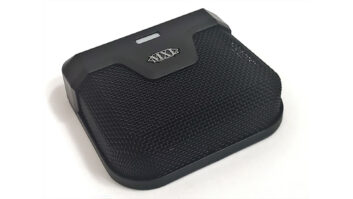Amplifier: a device that tracks the amplitude of an incoming
signal and proportionally increases the voltage, current or power of
the signal by adding power from another source.
Attenuation: the process of decreasing the amplitude of a
signal as it passes from one point to another. Analog attenuation
circuits typically use resistors to reduce the voltage of a signal. In
audio, the effect of such attenuators is usually expressed in decibels.
See decibel, resistor.
Balanced line: An audio line comprising three
conductors—two carrying signal and a ground (shield) wire, where
one of the signal wires carries the sound and the other carries an
inverted copy. When the signal reaches the destination, the inverted
copy is flipped and added to the original. Any noise that has been
induced into the signal is also inverted. When this is combined with
the “uninverted” noise, it cancels it out. Balanced lines thus are less
susceptible to hum and can carry audio signals over longer distances.
Balanced audio lines typically use 3-pin XLR or 1/4-inch
tip-ring-sleeve (TRS) phone connectors.
Capacitor microphone: an alternate, less-used term for
condenser microphone.
Cardioid microphone: a microphone with a directional pickup
pattern that is most sensitive to sounds coming from the front and
sides while rejecting sounds coming from the rear. The pickup pattern
is roughly heart-shaped when viewed from above, hence the name
“cardioid.”
Condenser microphone: a microphone that picks up sounds via
an electrically charged, metallized diaphragm, which is separated from
a conductive back plate by a thin air layer. Sound waves striking the
diaphragm cause a minuscule voltage change, which is increased by a
tiny amplifier circuit within the mic body. Because power is required
by both the microphone capsule and the amplifier, condenser microphones
must have a power source, which can be a battery inside the mic body or
“phantom” power from a mixing console or external power supply.
dB: abbreviation for “decibel.” See decibel.
dBm: a term expressing an electrical power level, referenced
to 1 milliwatt (i.e., 0 dBm = 1 mW). Originally, dBm was used to
express the power dissipated in telephone applications with 600-ohm
impedances, but it is not necessarily referenced to a particular
impedance.
dBu: a means of expressing voltage referenced so that 0 dBu
equals 0.775 volts, regardless of impedance. One mW of power is
dissipated if 0.775 volts is applied to a 600-ohm load, so when the
load impedance is 600 ohms, 0 dBu = 0 dBm.
dBV: a means of expressing voltage, referenced so that 0 dBV
equals 1-volt RMS, regardless of impedance.
dBv: synonymous with dBu but rarely used due to confusion
with dBV. See dBu.
decibel: a unit of measure used to logarithmically express
ratios of change in power or signal levels. Equal to one-tenth of a Bel
(named for Alexander Graham Bell).
Dynamic microphone: a transducer that relies on the law of
induction, with an output proportional to the velocity of a moving
element within a magnetic field. The most common type is the
moving-coil microphone, which picks up sounds when sound waves strike a
diaphragm attached to a coil of wire. When the coil moves within the
magnetic structure of the microphone, it creates an output voltage. The
process is exactly the reverse of the way a speaker operates.
Moving-coil dynamic microphones tend to be extremely rugged, making
them well-suited for most sound reinforcement applications. The other
common type of dynamic microphone is the ribbon mic. See ribbon
microphone.
Dynamic range: a ratio (expressed in dBs) of the difference
between the softest and the loudest sound that can be produced,
reproduced or captured by a musical instrument or audio device.
Feedback: a condition where the output of a circuit recycles
through its input. Acoustic feedback is a whine or howl that occurs in
live audio situations when an amplified sound re-enters a sound system
through the same microphone (or guitar pickup) that reproduced the
original source, creating a loop. Feedback also can be used in signal
processing; for example, part of a signal routed through a digital
delay can be fed back into the delay to create a more complex effect.
This is also called “regeneration.”
Highpass filter: a circuit designed to attenuate, or cut,
frequencies that fall below some designated point, while allowing
higher frequencies to pass unaffected.
Hypercardioid: a variation of the cardioid microphone pickup
pattern. A hypercardioid microphone is most sensitive at the front and
sides, while rejecting sounds entering 120° to the rear.
Impedance: Measured in ohms, this is a way of expressing a
circuit’s opposition (resistance and reactance) to a signal or current
attempting to pass through. The practical difference between impedance
and resistance is that impedance changes as a function of
frequency.
Omnidirectional microphone: a microphone that is equally
sensitive to sounds coming from all directions.
Phantom power: a method of powering condenser microphones by
sending DC current (typically 9 to 52 volts) over the same mic cable
that carries the audio signal. “Phantom” is derived from the fact that
there is no visible power cord and the voltage is not perceptible in
the audio path.
Polar pattern: A circular, 2-D plot that indicates the
directional response of a transducer. While polar patterns are commonly
used to show microphone pickup patterns, they can also indicate the
dispersion of a speaker. Interpreting polar patterns, even with
something as simple as a common cardioid microphone, can be fairly
complex. For one, the polar response shown on paper doesn’t indicate
the fact that a microphone’s pickup pattern is actually a 3-D space
around the mic. Second, the polar response of any microphone is
frequency-dependent. For example, an ultradirectional “shotgun”
microphone is extremely directional at high frequencies and much less
so at low frequencies.
Proximity effect: a boost in the low-frequency response of a
directional microphone that occurs when the sound source is relatively
close to the microphone. The phenomenon begins when the source is about
two feet away from the mic capsule and becomes more noticeable as the
subject gets closer to the mic. Used properly, a singer can use the
proximity effect as a means of adding fullness to a voice; however, the
effect can also emphasize nondesireable low-frequency noises such as
breath sounds and popping consonants (“p” and “b” sounds).
Ribbon microphone: a type of dynamic microphone that uses a
thin metal ribbon placed between the poles of a magnet. Ribbon mics are
typically bidirectional, meaning they pick up sounds equally well from
either side of the mic.
Roll-off filter: a circuit that attenuates a signal that is
above (lowpass filter) or below (highpass filter) a specified
frequency. For example, microphones frequently have a bass roll-off
filter to remove wind noise and/or excessive breath pops.
Spaced pair: a stereo microphone technique where two
microphones are pointed directly at the source separated by two feet or
more. Depending on the mic-to-source distance, this method can provide
an extremely wide (occasionally exaggerated) stereo perspective. See
X-Y miking.
Supercardioid microphone: a variation of the cardioid
microphone that is most sensitive at the front while rejecting sounds
entering 150° to the rear.
Transducer: a device that transforms energy from one form to
another. Examples of electromechanical transducers include microphones
(which convert acoustic pressure into electrical voltage) and
loudspeakers (which convert voltages into acoustic pressure).
XLR: Developed by ITT/Cannon, XLRs are rugged, locking
multipin connectors frequently used in professional audio equipment.
While 3-pin XLRs are most commonly seen on microphones and console
inputs, other configurations also exist, such as 4-pin XLRs (a standard
for stage intercom systems) and 5-pin XLRs (often used on stereo
microphones).
X-Y miking: a stereo microphone technique where two
directional mics (typically cardioid) cross at an angle from 90°
to 130°, with their capsules placed closely together. In most
cases, X-Y miking provides good stereo separation with a well-balanced
image. See spaced pair.







